
8 minute read
The Old Parsonage Charlie McCormick
TulipMANIA
Charlie McCormick has a passion for tulips, which fill the garden of The Old Parsonage in Dorset with vivid colour and are brought indoors for painterly displays
WORDS JACKY HOBBS PHOTOGRAPHS CLIVE NICHOLS
There are thousands of colourful tulips for cutting in the Dorset potager of New Zealand-born plantsman and florist Charlie McCormick. They continue in the ‘more grown up’ parterre beds to the east of the early 19th-century parsonage he shares with his husband, architectural and interior designer Ben Pentreath, in the village of Little Bredy. This is their country bolthole, a place for Charlie to garden and grow flowers for cutting; bucketfuls of springtime tulip blooms end up cheerfully furnishing their London apartment.
“I grow flowers for pleasure,” says Charlie, “but my enthusiasm led to surplus stems, so I developed a seasonal special events floristry business founded largely on my main passions: brilliant tulips and luxurious dahlias.”
The Old Parsonage sits squarely on a one-acre plot, the enveloping garden sloping steeply away to the south, down to the village church and woodland below. “When we moved here ten years ago, the divide between the church meadow and the adjoining garden was negligible; wild bluebells and cowslips were springing up either side of the
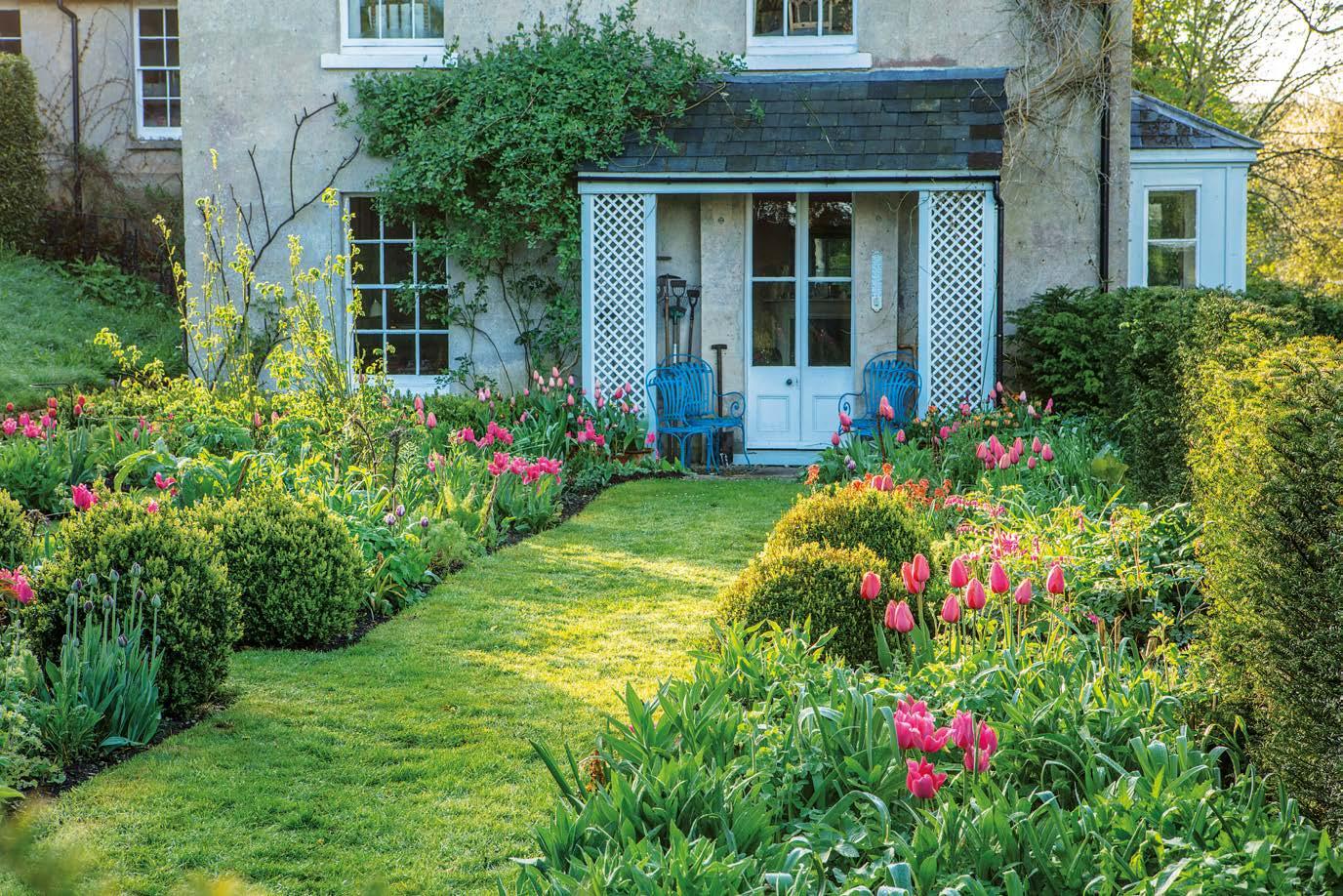
Above An expanse of flat lawn was transformed when Charlie cut six large beds into it for tulips and perennials. Below Charlie McCormick in the colourful garden of The Old Parsonage. Parson’s gate,” says Charlie. This side remains little altered, but to the sun-soaked west he has cultivated flowers en masse in the lawn garden parterre, the dahlia terrace and the cut-flower potager.
“A flat, uninterrupted expanse of lawn lay to the west of the house,” Charlie continues. “Visually it was boring, but it was good for croquet.” Four years ago, he impulsively dug it up to create six new beds that now burgeon year-round with structural box balls, hellebores and snowdrops in winter, and peonies, roses, lavender, delphiniums and cardoons through summer. In late spring, a restrained palette of pink and purple tulips such as ‘Pink Impression’, ‘Cherry Delight’, ‘Black Hero’ and ‘Rems Favourite’ colours the lush garden. Charlie also restored the crumbling stone wall that held the lawned garden aloft and, at its base, created a new 35-metre border that is devoted solely to dahlias for cutting: it’s quite a spectacle in full bloom. In the far bottom corner of the plot, concealed from view by the garden’s steeply sloping aspect and closeted in woven willow and beech hedging, lies a large, rectangular potager, dedicated to growing tulips for cutting and vegetables for showing. “The existing vegetable
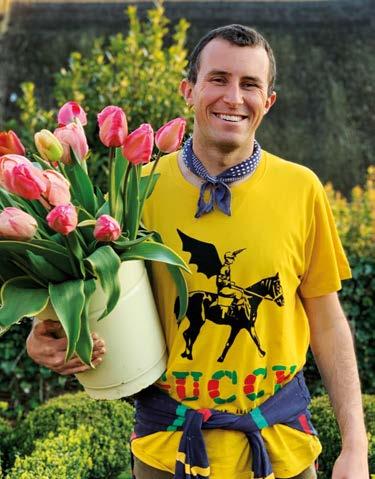


garden was fragmented Above left A wine red and haphazard. I flower of tulip ‘Merlot’. reorganised the space, Above right Vases of tulips line up along the creating bigger, more wooden table in Charlie regular and accessible and Ben’s cheery kitchen. blocks and rows,” Left Flamboyant parrot explains Charlie. tulips flare in a vase. Below The Darwin tulip He halved the space ‘Pink Impression’ blooms vertically and lined the among wallflowers and descending walkway box balls in the parterre. with box. Parallel flower and vegetable beds now run horizontally across the slope, sub-divided by wooden walkways or salvaged narrow brick paths. Rows of Victorian-style glass cloches and hazel sweet pea teepees create practical yet decorative divisions.
“I grew up on my grandparent’s farm in Canterbury, New Zealand. Grandfather grew vegetables and granny grew cut flowers,” Charlie reminisces. He successfully grew show vegetables from an early age, and his competitive streak has not dimmed. He’s now a regular prize winner at the local Dorset country shows. The secret of his success? “Home-made and spent mushroom compost with heaps of farmyard manure,” Charlie reveals. He enriches the free-draining, chalky soil to ensure fabulous flowers and enormous vegetables.
Charlie’s cut-flower tulip selection is eye-catching and exuberant, unhampered by set ideas of how colour should work in the garden. “I was exposed to masses of irresistibly colourful tulips while working for fellow New Zealander and tulip enthusiast, Land Gardener Bridget Elworthy. She grows cut flowers commercially in the walled gardens at Wardington Manor, Oxfordshire,” he explains, going on to note that he is “drawn to fun and colour”, with a taste for mixing huge-headed, intense, plain tulips with exotic parrots and gorgeous stripes.



“I plant masses of vivid pink and orange Darwin ‘Impression’ tulips – their heads are colossal,” remarks Charlie, “but I’m also mad about stripes, and Tulipa ‘Helmar’ is a work of art.” Plumsplashed ‘Rems Favourite’ is another showstopper, while flamboyant parrot tulips “are trickier to grow but you need fewer to impress. A single stem of Tulipa ‘Professor Röntgen’ can virtually fill a room with its presence,” according to Charlie. “I’m now planting masses of in-vogue nudes, bronzes and brown-flowered cultivars: single ‘Brown Sugar’ and flouncy doubles ‘Brownie’, ‘La Belle Époque’ and ‘Copper Image’. Rust-coloured Tulipa ‘Bruine Wimpel’, makes a beautiful foil to the richer, metallic tones, but is difficult to find,” he adds.
Charlie’s tulip mix evolves as he discovers new cultivars offered by specialist suppliers such as Peter Spring perfection: a Nyssen, de Jager and Parkers Bulbs. Each season he pink-blossomed cherry hangs over the path that starts completely afresh, discarding all of last year’s winds its way around tulips, planting only new, plump bulbs that render one of the pools. perfect picking-flowers. “I order around 8,000 bulbs

Top left ‘Pink Impression’, ‘Cherry Delight’ and ‘Helmar’ with glass cloches in the potager. Top right Double late tulip ‘Black Hero’. Above right Pink ‘Ollioules’ with ‘Merlot’ and yellow ‘Strong Gold’. Above left In-vogue ‘Brown Sugar’ has richly toned gold and copper coloured blooms. and plant them out in November, after the first frost, to reduce the risk of tulip fire. Bulbs are packed in colour blocks or rows. Tighter planting produces straighter stems and helps cut down on weeds,” he explains. He places them, ‘almost touching’, in compost-lined trenches. “Last year, on a whim, I decided to mix them all up and tipped them all into one big wheelbarrow.” Once sufficiently shuffled Charlie planted them, en masse, in a huge trench. The result is a joyful and carefree tulip pick-and-mix.
Although Charlie grows tulips, and other flowers, for cutting, he rarely mixes them. “They need no distraction,” he insists. Instead, in the parsonage’s flower room, surrounded by assorted vessels, he pops single and fistfuls of dazzling tulips in bottles, jugs and jars, “leaving room for them to expand, grow and reveal their true personality.” These decorate every room in the house, including the kitchen. They fade faster in the heat here, but he explains: “I enjoy them even as they perish, as they change colour, fade and become alluringly transparent.” n



Literary Bronze Water Features & Sculptures Awarded 5 Gold Stars at the RHS Chelsea Flower Show

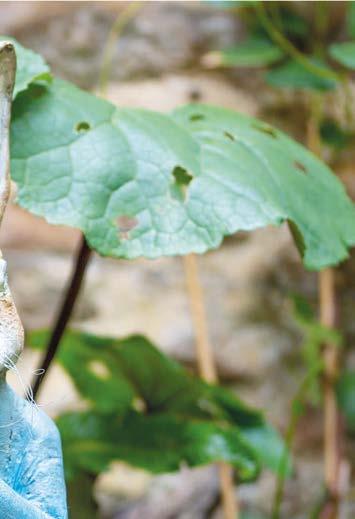
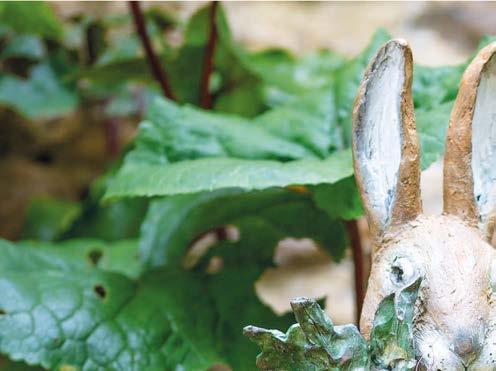
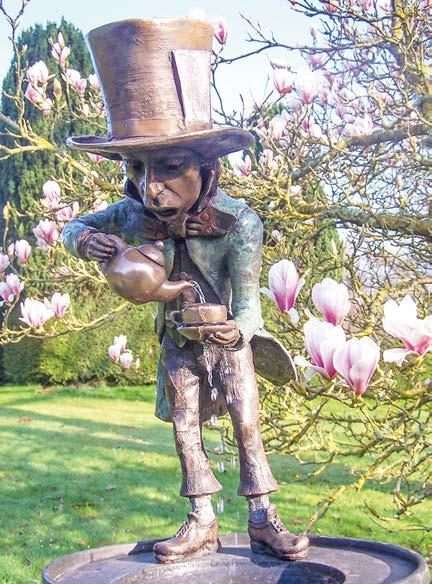

e Mad Hatter water feature


Robert and James, better known as Bob and Jim, have been best of friends for over 30 years. ey share a passion for stories, illustration and sculpture, and together they have embarked on many creative adventures.
Just over 10 years ago, Jim attended the RHS Chelsea Flower Show for the rst time. It was an extraordinary day, brimming with colour, inspiration and the surprising realisation that there were no sculptures woven around stories.
is was the moment that Alice in Wonderland rose from the page and the idea of a limited-edition run of bronze sculptures based on the classic story was ignited in Jim’s creative and quirky mind. Turning a page in a book to see an illustration that brings the story to life is magical.
Even in today’s digital world, the page of the book is where it all begins. English classics such as Lewis Carroll’s ‘Alice’s Adventures In Wonderland’ illustrated by Sir John Tenniel, Beatrix Potter’s ‘Peter Rabbit’ and Cicely Mary Barker’s ‘ e Flower Fairies’ are faithfully modelled from the original illustrations. Robert and James were invited by Penguin books, who own the copyright of these treasured creations, to work directly from the archives held at the Victoria and Albert Museum in London.
e pair use old, hand-made tools and ngerprints to press, move and model the clay into life, capturing the breath of the characters, as if they have momentarily stepped out of the book and into the three-dimensional world.
Once modelled in clay, the pieces are cast in bronze and the highly collectable sculptures are installed in both homes and gardens, to weave their unique magic. Robert James were kindly invited to exhibit at the Philly Flower Show back in 2015 celebrating ‘Brilliant - e Best Of British’. Since then they have received commissions from right across all states.
“It is our fairy tale come true, our American dream and our vision in full bloom!” says Robert James.
SLOPE & GLORY

A spring garden combining exuberant borders with woodland and wildflowers, Warborough House revels in its position on that rarest of habitats: a Norfolk hill







